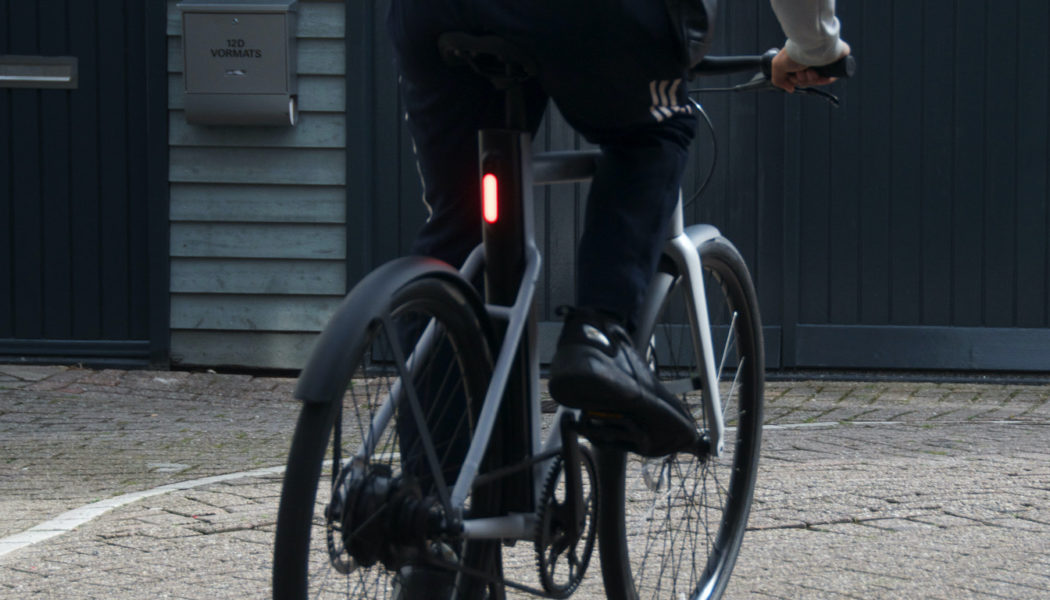Cowboy has returned with its third-generation e-bike. It’s still the best-looking pedal-assisted electric bike with a removable battery that I’ve ever seen having carried forward the same physical design as the original Cowboy. While the Cowboy 2 from last year was sporty, the Cowboy 3 is mature, focusing on safety rather than fun.
The Cowboy 3 is fitted with a variety of safety features including automatic crash detection, a slower top speed, and new puncture-resistant tires of Cowboy design. Version three, like the previous model, also has integrated lighting, with a rear light that flashes red when braking. And believe it or not, Cowboy’s finally making fenders.
It’s as if this Belgian startup wants to become the Volvo of e-bikes. Not that that’s a bad thing.
The headline feature is automatic crash detection, which the company calls an industry first. It’s available on both Cowboy 3 and older Cowboy 2 bikes via a free software update. Crash detection works by analyzing data collected from the wheel’s speed sensor, torque sensor, and accelerometer to determine if a crash occurred. The company says it can tell the difference between a crash and emergency braking, dropping your bike on its side, hitting a pothole, or riding over cobblestones.
If a crash is detected, the rider has 60 seconds to confirm they’re okay in the app, or else the SIM card integrated into the Cowboy e-bike sends an alert to one, or both, of your predefined emergency contacts. It also sends along a real-time map showing the rider’s position measured by the bike’s GPS radio.
I was able to simulate a crash with the help of a soft couch. After dropping the bike while holding the brake and pressing down on a pedal, the front and rear lights started flashing rapidly to draw attention to the area. At the same time, a text message was received by my emergency contact saying I “might have been involved in a bike accident” with my approximate street address and a link to a live map showing my precise location. I can imagine this being a useful and even life-saving feature if crash detection performs this well in real-life scenarios. Otherwise, false alarms could create a lot of stress for loved ones (Cowboy claims a false positive rate of “close to zero”).
:no_upscale()/cdn.vox-cdn.com/uploads/chorus_asset/file/21907036/verge_DSC_0787_2040pxl.jpg)
:no_upscale()/cdn.vox-cdn.com/uploads/chorus_asset/file/21907035/verge_DSC_0791_2040pxl.jpg)
:no_upscale()/cdn.vox-cdn.com/uploads/chorus_asset/file/21907028/verge_DSC_0895_2040pxl.jpg)
:no_upscale()/cdn.vox-cdn.com/uploads/chorus_asset/file/21907032/verge_DSC_0847_2040pxl.jpg)
Another safety feature was added by taking something away: off-road mode, a setting intended for riding Cowboys on private property. Cowboy e-bikes are now capped at the European limit of 25km/h (15.5mph). Previously, Cowboy’s off-road mode sneakily boosted the speed cap to 30km/h (19mph) to complement the e-bike’s sporty riding position. In practice, I imagine that many, if not most, Cowboy owners used that mode all the time. I sure did, especially when beyond the city limits where I regularly bike between 25-30km/h. I really missed the faster, more exciting mode in my testing. I’m told that Cowboy removed it for safety and insurance reasons: Cowboy offers owners Easy Rider insurance plans starting at €8 per month for theft or €10 per month to add damage coverage.
The Cowboy 3 does have a free Find My Bike feature that uses GPS and Bluetooth to help locate your bike. But you’ll need to pay at least €8 per month to receive theft detection notifications. The anti-theft protection kicks in two minutes after the Cowboy is turned off. Then, whenever your bike is jostled, presumably by a thief, it’ll send an alert to your phone showing the reported GPS location. The bike can then be tracked with the help of the (very good) Cowboy app with Bluetooth allowing you to hone in on your bike with greater precision.
My test bike had theft detection enabled and it worked for the most part. When enabled, the bike’s lights flash briefly (there’s no siren or warning sound) and the alert arrives quickly in the app. You can then ignore it or hit “Find My Bike” and take your chances with confronting a would-be thief or someone who innocently bumped your bike in the shared bike rack.
As for the ride, Cowboy’s own silent 250W rear-hub motor coupled with a new, longer-lasting Gates Carbon Belt drive and lower gear ratio produces a highly intuitive experience. Power is delivered as soon as the bike detects pressure on the pedal for effortless getaways in the flats, and then the bike’s speed and torque sensors constantly adjust power delivery as your pace and pedaling change. When I tested it on hills, however, I felt the bike lacked the vertical oomph delivered by other single-speed belt-driven bikes like Gogoro’s Eeyo 1S, requiring more exertion than I expected. Nevertheless, overall the Cowboy continues to deliver one of, if not the most natural pedal-assisted ride experiences of any e-bike I’ve tested.
My range test delivered 70.5km (43.8 miles) from the 360Wh battery, which is exactly in line with Cowboy’s “up to 70km” claim. Best of all, that battery can be removed and taken inside for convenient charging. The bike is still rideable with a dead battery, but many will struggle to pedal a 16.9kg / 37-pound bike over long distances with just a single gear.
New this year is an automatic startup option that uses Bluetooth to detect when you’re nearby. It works so long as the app is running in the background. The new feature means you can leave your phone in a pocket or bag when you’re ready to ride. In practice, it works pretty well: the bike sensed me approaching and then required me to move it a little to actually turn the motor on. The bike can also be set to turn off automatically, or not, after a period of inactivity, giving you a chance to lock it up with a chain (or two) and walk away without triggering the anti-theft alerts.
After a software update, the Cowboy 3 can now be turned on without a smartphone. The ”Manual Unlock” mode allows the e-bike to be turned on by ejecting and re-inserting the battery within 20 seconds. It’s not very elegant, and requires that you carry the key, but it could keep you from getting stranded should you lose your smartphone or its battery dies.
The last big feature for Cowboy owners is the free Cowboy Mobile Service. While under the two-year guarantee, Cowboy will send a technician to your home, office, or places in between to repair your bike. The CMS service is currently available in 25 European cities, expanding to 70 by the end of the year, Cowboy tells me. Rad Power, for example, offers a similar service but charges a fee for each use.
Other observations:
:no_upscale()/cdn.vox-cdn.com/uploads/chorus_asset/file/21907088/app-air-quality-benl_w_3sm.0.jpg)
- Cowboys don’t have throttles — they’re pedal assist only, and it’s either on or off, without power options like eco or sport found on other e-bikes.
- The spongy grips, stock saddle, and wide puncture-resistant tires of Cowboy design did a fine job of gobbling up road vibrations, even on the bumpy bricked roads common in Amsterdam.
- The Cowboy app will soon, by early October, inform riders about the air quality in the area and suggest the least polluted route.
- Cowboy 3 is now available in two shades of gray to go along with the black model.
- The LEDs in the battery meter on the top tube can be set to bright or dim and are mostly visible in the sun in bright mode.
- The Cowboy logo above the battery meter isn’t a power button, but it should be.
- Cowboy 3 weighs 16.9kg / 37 pounds, four ounces, making it about 900 grams heavier than the Cowboy 2 due mainly to the beefy new tires. The mudguards add some additional, undisclosed weight. It’s also made to fit relatively tall riders, measuring 170 to 195cm (five feet, seven inches to six feet, five inches).
- Battery charges in about 3.5 hours.
- Hydraulic disc brakes stop the bike with confidence.
- The Cowboy app is one of the best in the business with its clean layout and features that make sense.
:no_upscale()/cdn.vox-cdn.com/uploads/chorus_asset/file/21906945/verge_DSC_1327_2040pxl.jpg)
The Cowboy 3 is priced at €2,290 / £1,990 (about $2,665). That’s €300 more than both last year’s Cowboy 2 and VanMoof’s comparable S3 and X3 commuter e-bikes. But with a VanMoof, the price includes fenders, which are an €89 option from Cowboy, and a kickstand, which Cowboy doesn’t offer at all. At least Cowboy now ships its bikes with bells. Knowing that you’ll get a removable battery, free mobile repairs, and free crash detection helps make the Cowboy’s price tag a little easier to accept.
The third-generation Cowboy is available in Austria, Belgium, France, Germany, Italy, Luxembourg, Spain, the Netherlands, and the UK, with Denmark in the works. US sales will happen someday, but right now, the European e-bike market is ten times the US market, says Cowboy, so it’s not in a rush.
Cowboy’s clearly been busy putting the €33 million in funding it’s raised since 2018 to good use to add and improve features while maintaining a pace of slow and steady expansion. Cowboy 3 is an excellent electric bike, made better through a selection of free and subscription-based services that should add real value over the lifetime of the bike.
Still, I can’t help but think that it’s a little confused. The geometry puts the rider into a sporty riding position yet its top, pedal-assisted speed has been reduced by 17 percent from last year’s model. And it’s sold as a city commuter but lacks urban necessities that should be included as standard components. The Cowboy 3 reminds me of a college graduate, torn between the recklessness of youth and the stodgy demands of the corporate world, knowing that growing up is inescapable.
Update October 18th, 8:08AM ET: Updated review text after Cowboy rolled out new Manual Unlock procedure to start the Cowboy 3 without a smartphone.
Photography by Thomas Ricker / The Verge
Vox Media has affiliate partnerships. These do not influence editorial content, though Vox Media may earn commissions for products purchased via affiliate links. For more information, see our ethics policy.









